Peace lilies are one of the most popular houseplants, especially as gifts to new homeowners. These beautiful indoor plants bring life and colour to low light spots while also purifying the air. Simply tuck it into a simple container and let the glossy leaves and stunning flowers steal the spotlight. A peace lily is hardy and forgiving, but there is a trick to getting those gorgeous flowers to bloom. When you practice good peace lily care, the plants can live for years and flower over and over again. Below were are going to give you our 5 best tips to grow a healthy peace lily plant.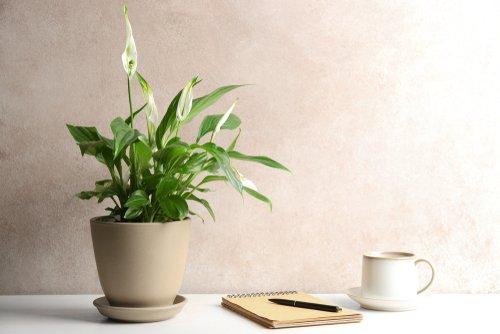
What is a Peace Lily?
The Spathiphyllums or peace lilies are native to the tropical regions of the Americas and south-eastern Asia. In those regions, peace lilies grow happily outside, but in most other areas of the world they need to be grown inside, as houseplants, in order to control the humidity levels these plants require. In nature, these tropical evergreens survive of the forest floor where they receive dappled sunlight and consistent moisture. It is by replicating these conditions in the home that we get a happy, healthy peace lily.
You are watching: 15 Best Tips to Grow a Healthy Peace Lily Plant
With enough light, peace lilies produce off-white flowers starting in early summer and can bloom throughout the year in the right conditions. Dense clumps of glossy, emerald, green foliage and these snowy white flowers on long stems are the hallmarks of the peace lily.
How to Grow a Peace Lily
Below we are going to discuss the top 15 best tips we have for growing a healthy peace lily in your home.
1: Light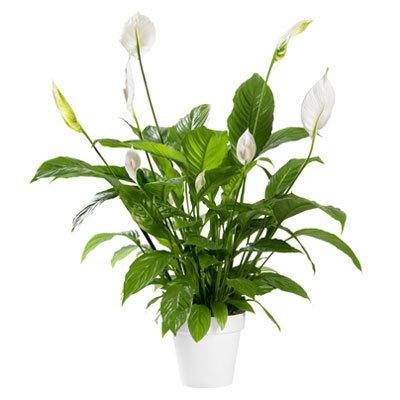
Peace lilies are the perfect option low light spaces because they can easily thrive in shade or partial shade. They also grow well under fluorescent lighting, making them the perfect plant to liven up your office desk. A peace lily is also perfect to liven up the dark corner of a living room, creating a lush, botanical look.
Do not place your peace lily in direct sunlight. Direct sunlight will cause damage to your lily, scorching the leaves. You should also avoid positioning them in or near the direct stream of heaters or air conditioners. Peace lilies are incredibly sensitive to cold temperatures and dry air.
It is important to remember that when grown in low light, a peace lily will rarely bloom. Which is fantastic if you are looking for a foliage over flowers. If you want flowers, however, you need to place the peace lily where it will receive bright, indirect light. And east-facing window is ideal, as the plant will be exposed to the bright morning sun but will avoid the intensity of the midday rays.
2: Temperature
Peace lilies enjoy a consistent temperature of around 18 to 26°C. It is important that you protect your plant from drafts, cold, and any drastic changes in temperatures. This is why we do not recommend placing your peace lily near a door that constantly opens. Especially if it lets in cold air.
Remember, peace lilies are a tropical plant and do best at an average temperature of 21°C. Keep them away from cold and drafty windows. Your peace lily also enjoys a high level of humidity. Misting their leaves or placing their pot on a moistened tray of gravel can help increase the humidity around the plant, mimicking its natural environment.
If you want to grow peace lilies outside, they require a tropical, sub-tropical, or warm microclimate in warm temperate to survive. Cold regions, like Melbourne, are not suitable for growing a healthy peace lily plant outdoors.
3: Fertilising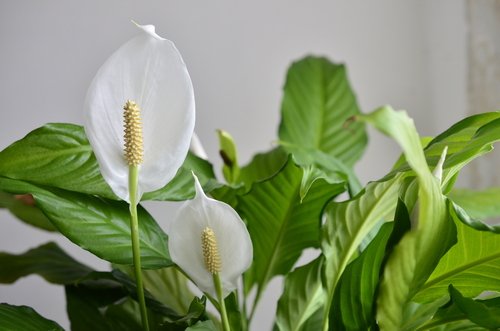
Peace lilies do like fertiliser. In spring and summer, we recommend using an organic houseplant fertiliser to help your lily bloom. Peace lilies are extremely sensitive to chemical fertilisers, however, so ensure you use an organic fertiliser. Also, if you have freshly planted your peace lily, around a month after planting, your lily will need fertilising. Again, choose an organic, houseplant fertiliser that you can apply either directly to the soil or mixed into water. A controlled release fertiliser is also a great option. Peace lilies are not heavy feeders so only feed in spring and summer to encourage growth.
If your peace lily has green flowers, weak looking flowers, or a general lack of flowers, despite getting enough sunlight, this can be due to improper fertilising. If the flowers are green, we recommend you cutback on fertilising. In the case of flowers that look weak or if there are a lack of flowers, try switching to a fertiliser made specifically for flowering plants. Fertilisers for flowering plants typically have a higher level of phosphorous in them, which helps plants to bloom better.
4: Watering for a Healthy Peace Lily
Due to their tropical, humid natural environment, peace lilies like to be watered a lot. But it is also important to remember to let the plant dry out between waterings. A Peace Lily will actually droop a little when it is thirsty, letting you know that it needs water. So if you pay close attention to your plant and work out when it usually starts to sag, you can plan to water the day before.
In summer, it is a good rule of thumb to water about once a week and spritz leaves to help keep your peace lily hydrated. If your lily seems to completely droop, don’t worry. Continue to water and spritz, and give the peace lily a chance to revive. If you are concerned that the water is chlorine-heavy, let a container of water stand overnight before watering the plant. Peace lilies are sensitive to chemicals commonly found in tap water, including fluoride, which can cause brown leaf tips. Where possible, use filtered, room temperature water.
Your peace lily needs consistently moist soil but they don’t like sitting in standing water. As soon as the top inch of the soil is dry, water the plant until the overflow starts to come out of the bottom of the container. Wait until the water stops draining and then set the pot back in the saucer. Use your finger to check the moisture level of the soil before watering. If the surface of the soil is still moist, then you don’t need to water. If it is dry for the first centimetre or two, then it needs water.
5: Drainage
Peace lilies are incredibly susceptible to root rot. As a result, it is incredibly important to ensure the plant has a chance to dry out between waterings. It also needs a container that drains well. You will need a container with drainage holes and a saucer underneath to catch any water that drains out. If the plant begins to wilt, it is important to check the roots to make sure they are firm and light coloured, not soggy. If the roots are soggy, you are over watering your peace lily and the soil won’t be able to drain.
It is important that you don’t allow your peace lily to stand in a saucer of water. And if your plant is in an air-conditioned environment, consider misting your peace lily lightly with water, every day or two, to elevate the humidity.
6: How to Plant Your Healthy Peace Lily
A peace lily is happy growing in containers but they don’t like containers that are much larger than their root balls. It is important to select a container that has good drainage and is no more than 1/3 larger than the root ball of your peace lily. You should fill the container a third of the way with an indoor potting mix which contains not compost or bark. Soil that contains bark and/or compost is known to shelter pesky fungus gnats that not only harass your peace lily, but your other indoor plants as well. An indoor soil that uses coconut coir, however, is ideal as it helps the soil re-wet easily – perfect for a plant that loves being in moist soil.
Read more : World juniors: U.S. comes back to beat Canada in Buffalo blizzard
Place your lily in the container so that the top of the root ball is about an inch below the top of the rim. This will leave room for water. Fill in around the root ball with more of your chosen indoor potting mix. Finally, water the peace lily until water begins draining out the bottom of the pot. Once the water stops draining, place a saucer under the pot and set the peace lily in its new home. It really is as simple as that to plant a healthy peace lily plant.
7: Transplanting
If your peace lily’s roots begin to show, or it seems to be drinking up all its water within a few days, then it might be time to repot into a larger container. Your lily will gradually need to be moved into larger and larger containers. However, peace lilies won’t need to go into a pot larger 10 inches larger than the root ball. In fact, peace lilies are quite happy to be a bit crowded in their pots. You will know it’s time to repot when, as we said above, the plant is using up more water, the roots are showing, or the pace lily begins to wilt more frequently. At this point, the roots have taken up so much space in the pot, there’s not enough soil left to hold onto water, to keep the lily’s environment appropriately moist.
Choose your new container (we recommend only a few inches bigger than the peace lily’s root ball) and a well-draining, indoor potting mix. If you can find a potting soil with coconut coir, all the better, as this allows the soil to re-wet better. Then follow the potting tips above to repot your peace lily.
In general, repotting annually, in the spring, is good for your peace lily. The plant will appreciate the refreshed soil and a little more growing space.
A peace lily may get to the point where it is so large it will need to be divided. This can be done by removing the peace lily from its pot and splitting it into smaller plants. Ensure you leave several leaves per clump. Because peace lilies grow from rhizomes, they can tolerate a bit of roughness when it comes to dividing. Now you can repot the lilies in a series of smaller pots – using the advice we’ve given you above – and either place them throughout your home, or give them as gifts to friends and family!
8: Blooms
Part of the appeal of the peace lily are the stunning white flowers or spathes. While some people buy the plant as a stunning, dark green foliage plant, for most, it is the snowy white flowers that are most appealing. Expect your peace lily to show off its flowers in spring, but some very happy healthy peace lily plants might bloom again in autumn and even all year round. After the flower fades, it is important to remove the spent flower by cutting it off at the base. The plant won’t flower again from the same spot. But what happens if your peace lily won’t flower at all? Below are some reasons why your plant might not be blooming and what to do!
You Have a Very Young Peace Lily
Sometimes, if your peace lily is failing to bloom, it’s because the peace lily is too young to produce flowers. Commercial growers of indoor and outdoor plants use gibberellic acid to force peace lilies to bloom. Gibberellic acid is a potent hormone that controls the growth and development of plants. This causes plants to increase their stem, leaf, and root growth, so they can be sold faster. If you bought a peace lily that already had a flower or two on it, it is likely that it was forced to bloom using gibberellic acid. Give the peace lily a year to settle in your home and it should start blooming normally.
Older Plants
If your plant is quite old, it may fail to bloom. When a peace lily gets old, the plant will fail to bloom for a long time. This will also be accompanied by other symptoms, including new leaves that yellow far too soon. All of this leaves the plant with poor nutrition that ultimately impairs its growth and leads to the failure to bloom. So if your peace lily is failing to bloom, you might want to check its age to rule this out. The lily should bloom at least once a year if it is in the optimal conditions for growth and development.
Insufficient Lighting
Another reason your peace lily might not be flowering is insufficient light. Too much light can stress a peace lily. Too little light is not enough for adequate photosynthesis which means you will be left with a mainly foliage plant. Both too much and too little light will cause your peace lily to stop blooming.
A peace lily, as we’ve discussed, prefers indirect bright sunlight. So place your plant near a window that receives enough sunlight, to ensure it will bloom.
Poor Watering
Your peace lily won’t flower it it’s not growing in moist soil. It needs enough water, along with light and warmth, to create the ideal, humid conditions to flower when the right time comes. Further, poor watering habits means nutrients can’t be translocated throughout the plant. This leaves the plant poorly fed and conditioned. And, as we’ve discussed above, the lack of water can cause peace lilies to wilt and droop easily.
Not Enough Fertiliser
Not fertilising your peace lily can mean it is not get the adequate nutrients it needs for cell division. This then leads to a lack of plant growth and development. Flowering is a part of a plant’s growth, so if the soil lacks nutrients, your peace lily will fail to bloom.
Soil pH can also be a reason why your peace lily isn’t growing and/or producing flowers as expected. You can try testing the soil with a specialised soil pH test kit to ensure the pH is within the right range. It should be somewhere between 5.8-6.5. If it isn’t in the correct range, then your potting mix has likely gone bad and the peace lily needs repotting in fresh soil.
Wrong Temperature
Temperature is a major factor that will stop peace lilies from flowering. When it’s too cold, like in winter, most plants don’t produce flowers as the buds die off. Your peace lily is no exception. A peace lily prefers temperatures of 18-26°C. It might fail to bloom if the temperature is too low or too high.
Very hot conditions means the lily is losing water too fast. This leaves it with very little room for growth and development, which will stop it from blooming. If it’s too cold, then it will stay in a kind of winter hibernation and also will not bloom. It can also lead to a moisture build up in the soil that can lead to root rot, to which peace lilies are highly susceptible.
9: Uses for Peace Lilies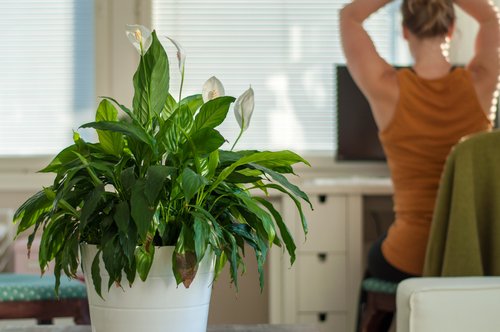
Surprisingly, there are many uses for peace lilies. As we know, they are one of the most beautiful, reliable, and easiest to grow of the indoor plants. They can grow in almost any indoor situation. If you want a stunning foliage plant, it is perfect for low light areas. If you want a plant that blooms with perfect, snowy white flowers, this plant loves indirect sunlight – even fluorescent lighting!
But did you know that peace lilies had other uses?
Peace lilies are known for being able to remove dangerous VOCs (Volatile Organic Compounds) from the air. VOCs are a silent but deadly threat to overall wellness. As we are now working and staying more in our homes, we are exposed to more of these compounds in our air quality. VOCs come from a wide range of consumer products – from furniture to cleaning chemicals to building materials – and build up in the indoor air environment.
Read more : 5 Best Paints for a Wood Fence
Overexposure to VOCs can cause light-headedness, dizziness, headaches, loss of visions and/or coordination, and memory impairment. Long term effects can be damage to the liver, kidneys, and central nervous system, and even some cancers.
However, NASA scientists have discovered that, among many other plants, healthy peace lilies are known to help purify and cleanse the air. The peace lily specifically can remove organic toxins including acetone, alcohols, benzene, formaldehyde, and TCE. And, because peace lilies give off a water vapour, they can help keep the air full of moisture and make the air easier to breathe. By placing peace lilies in your home, you can dramatically improve the air quality and your overall health.
10: Pruning Your Peace Lily
To ensure you have a healthy peace lily, pruning is definitely a necessity. Compared to a lot of other plants, peace lilies don’t need to be pruned frequently. However, if one or more of the peace lily’s limbs or leaves becomes yellow, brown, wilted, or dies, you may want to prune it back to keep the plant from wasting energy on the dying appendage.
Always use clean, sharp scissors or pruning shears to remove unhealthy or dead parts of the plant. Make sure your cuts are clean and near the soil level, without damaging the healthy tissue of the plant. While wilting and brown leaves can be a simple indication that the plant needs watering, it can also be a symptom of a more serious issue. If you are needing to prune your lily back more and more often, you need to start checking for other issues with your plant, including: under or overwatering, root rot, pests or other plant diseases.
11: Can I Grow a Peace Lily in Water?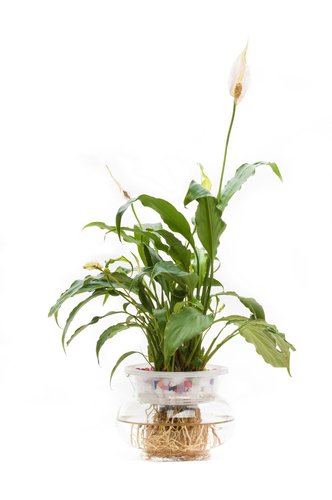
Yes, peace lilies are often sold growing in water alone. In fact, they are often paired in an aquarium with betta fish. When “planting” a peace lily in water, ideally the base of the plant should be suspended above the water line either by using a specially made insert or by using small river stones. This lets the roots grow down into the water but keeps the base of the plant and leaves from being constantly wet, which can cause rot.
A peace lily grown in water is generally considered a novelty plant that has adapted to an extreme growing condition by developing multiple tiny roots to feed rather than the larger roots needed for taking in nutrients from soil. These plants also tend to have shorter lifespans than peace lilies grown in soil. If you want to grow a healthy peace lily in water, we recommend buying one that is already growing in water as it will have developed the root system for those conditions.
12: Are Peace Lilies Poisonous?
While peace lilies are not true lilies, they are still in the Araceae family. This means they can be a risk to cats, dogs, and children. All parts of the peace lily, from the stems to leaves to the flowers, contain an irritating toxin that can be dangerous. While it technically isn’t poisonous, the compound it contains can be toxic and uncomfortable for pets and children alike. Even the pollen can cause irritation, if it is licked off paws or fur.
The toxin in question is called calcium oxalate crystals. They are needle sharp and shoot out of damaged parts of the plant. They are insoluble and persistent when they contact tissue. This causes an inflammatory reaction, accompanied by other symptoms including: an inflamed, irritated mouth or muzzle or throat, diarrhea, vomiting, excessive drooling, trouble breathing, and decreased appetite. It is always a good idea to seek help from a vet or doctor immediately if you are unsure about your pets’ or children’s health. While home remedies – like ensuring your pet or child drinks plenty of water – if they are in severe distress, it is best to seek professional advice.
13: Pest and Diseases
While peace lily owners typically encounter very few problems, there are the usual ones to consider, like spider mites and aphids, as well as yellowing or browning leaves. Below are some pests and diseases that can plague peace lilies:
Mealy Bugs
These appear as small, white, fluffy lumps near leaf stem bases. There are a range of products available for treating this pest, and multiple treatments may be needed to rid your plant of the infestation.
Scale Insects
These are generally small, brown lumps found on the underside of leave and stems. They can be very easily treated with a horticultural or pest oil.
Fungus Gnats
Fungus gnats grow in some types of potting soils. If they appear, try watering less frequently and make sure the top of the soil dries between waterings. If that solution doesn’t work, you may need to use an insecticide for home garden use, Bacillus thuringiensis, to kill the larvae that are developing in the soil.
Brown Leaf Tips/Edges
This is commonly caused by excessive light, over fertilisation, lack of water, or low humidity. Keep the peace lily on a tray of moistened gravel or try misting the leave to increase the humidity. Check if the soil has dried out and the lily needs water, pull back on the fertiliser, and move the peace lily out of direct sunlight.
Yellow Leaves
Yellow leaves tend to indicate the peace lily is being overwatered, underwatered, or the leaf is old. In the case of old leave, prune them back as close to the centre of the plant as possible. For plants that have been overwater, let the soil dry out before watering again and the plant may recover.
Dusty Leaves
Peace lily leaves are large and, like other plants with large leaves, tend to collect dust. Many people put the whole plant in the shower in order to hose it down! You can then apply your choice of leaf shine to the plant for beautiful, shiny leaves!
14: Misting Leaves for a Healthy Peace Lily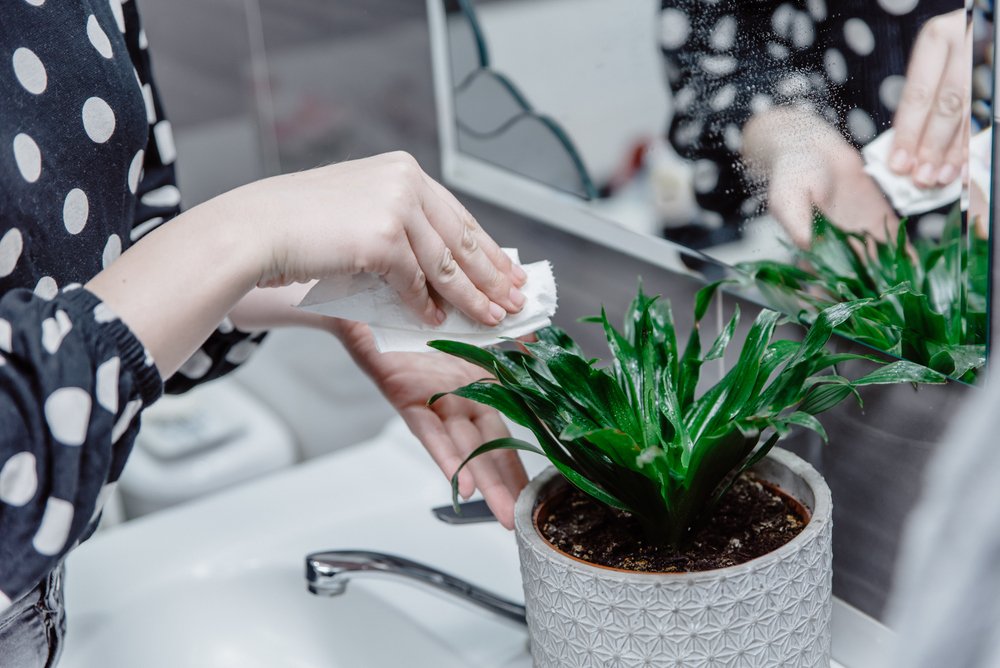
Healthy peace lilies thrive in high humidity, due to their tropical environment. So in addition to watering the soil, it is important to regularly mist your lily with a spray bottle to replicate the humid air of its rainforest environment. It is also important to mist your plant more frequently in summer – the more water you can supply, the healthier your plant will be.
Peace lilies are very sensitive to chlorine so, where possible, use dechlorinated water. You can “create” dechlorinate tap water by leaving it out at room temperature for 24 hours.
15: Provide Your Plant with Support
After potting or repotting your peace lily, the roots won’t immediately have a strong hold in the new soil. This can obviously make it difficult to get your plant to stay standing upright. If you’re having a difficult time balancing your plant, use a sturdy wooden stake or dowel to hold the peace lily upright. Bury the stake in the potting soil, taking care not to damage the root system, and use a plastic coated wire to attach the peace lily to the stake. Remove the stake when the plant has established its roots and is able to stand on its own.
Looking to own your own peace lily? Want to know more about keeping a healthy peace lily? Come into one of the many Aumanns Nursery & Garden Supplies centres today! Our helpful staff can point you in the right direction for your perfect new plant friend!
Source: https://gardencourte.com
Categories: Outdoor
